Yep, we’ve got more crystal fakes to talk about today. Looks like this problem is becoming more and more prevalent.
Get Educated about Crystal Fakes
One of my greatest joys is investigating and researching possible fake minerals and then teaching our Crystal Family about what’s popping up out there, keeping us educated so we can avoid the confusion that comes along with misrepresentations and crystal fakes. This way we can all make informed decisions when adding specimens to our sacred collections.
The three I’m going to discuss today aren’t what I would classify as a misrepresentation; these are straight up Crystal FAKES.
If you feel passionate about this too, please share this post in any way you prefer. (***There are some handy “SHARE” buttons you can use at the bottom of this post***).
Let’s dig into it!
Fake Moldavite
Moldavite has become quite the popular metaphysical stone. I’ve written before about its energy here.
Why would anyone want to create a synthetic version of this? Well, finding and mining for moldavite is getting harder.
Several years ago the Czech government changed the rules restricting miners abilities to dig no deeper than one meter deep (unless they’ve paid for a very expensive permit). In addition, it’s becoming increasingly harder to find the green rock since there’s a very limited supply of it and it’s becoming more and more scarce. It’s an expensive stone for this reason. So you can see the motivation for wanting to fake it.
Genuine Characteristics
Moldavite is most likely formed by an ancient meteorite’s violent impact with our planet. Because of the quick cooling that immediately followed, moldavite is characterized by lots of very small internal bubbles and random flow lines.
Another thing to look for in the real stuff can be found with a jeweler’s loupe. You’re looking for teeny-tiny worm-like wire filaments that won’t exist in the melted glass fakes.
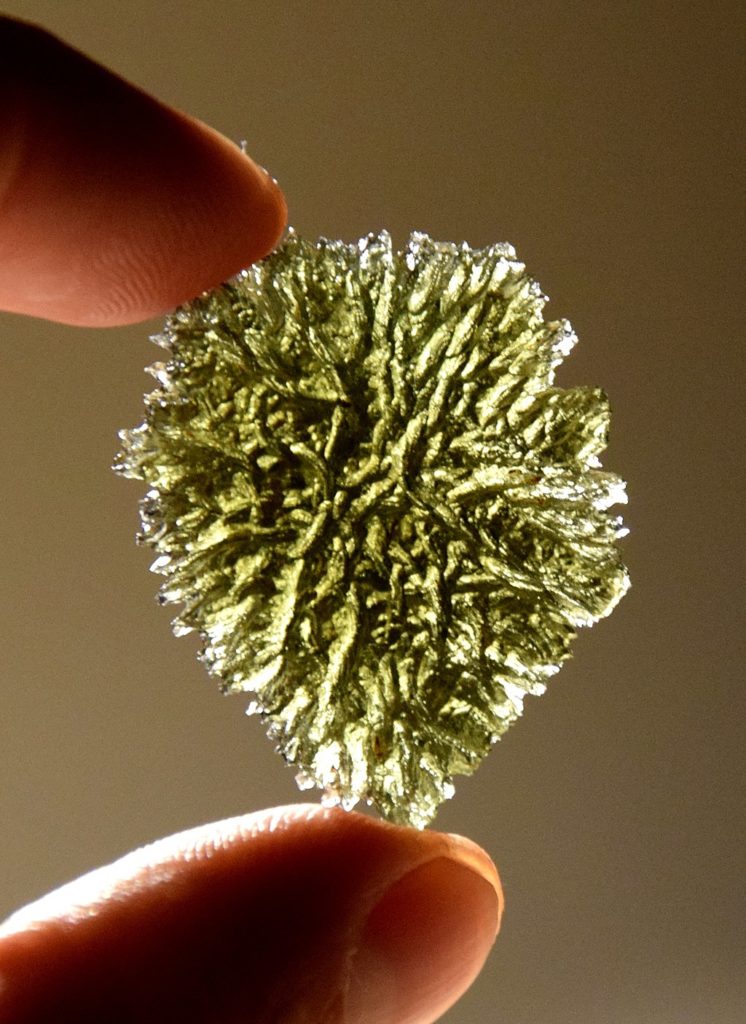
By Onohej zlatove [CC BY-SA 4.0 (https://creativecommons.org/licenses/by-sa/4.0)], from Wikimedia Commons
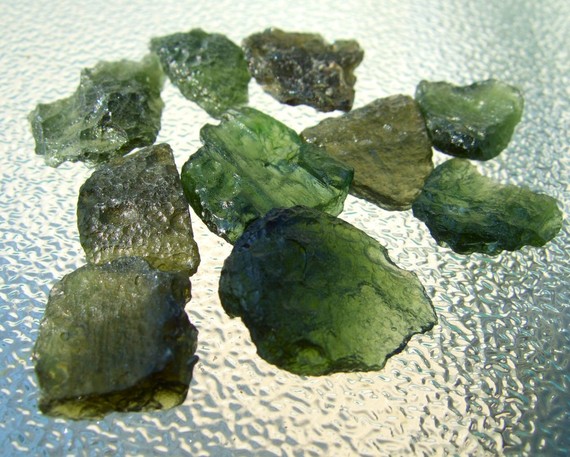
Fake Characteristics
Fake Moldavite, on the other hand, usually won’t exhibit much texture; they’ll be relatively perfect looking with no bubbles. Because much of the fake stuff is made of melted green glass (green bottle glass, melted down and then etched with acid to make it look like the real deal) they’ll have a wet-shiny look. In addition that bottle glass stuff will have a blue cast to it, whereas the real moldavite green has more of an olive tone.
It will be more uniform and smooth. If you’re looking at moldavite in bulk, you may also notice there are many pieces exhibiting the same shape and not randomly shaped at all.
Another trick, to kind of hide or disguise the fact that they look different from real moldavite…often times fakes will already be faceted or set into jewelry.
Also, large pieces of moldavite are extremely rare so, be aware.
As always, the price is a good indicator. If you find moldavite at a too-good-to-be-true price, start looking for signs of it being a fake.
Unfortunately, many of the moldavite fakes come from China, India, Japan or Thailand so if you’re buying online from those locales, be sure you’re buying from a reputable trusted seller.
Gold Lodestone
This was a new one I was alerted to recently. I had never heard of it but a couple of my students asked about it during our last term so it must be relatively new on the rock scene.
They really look like pyrite, don’t they?
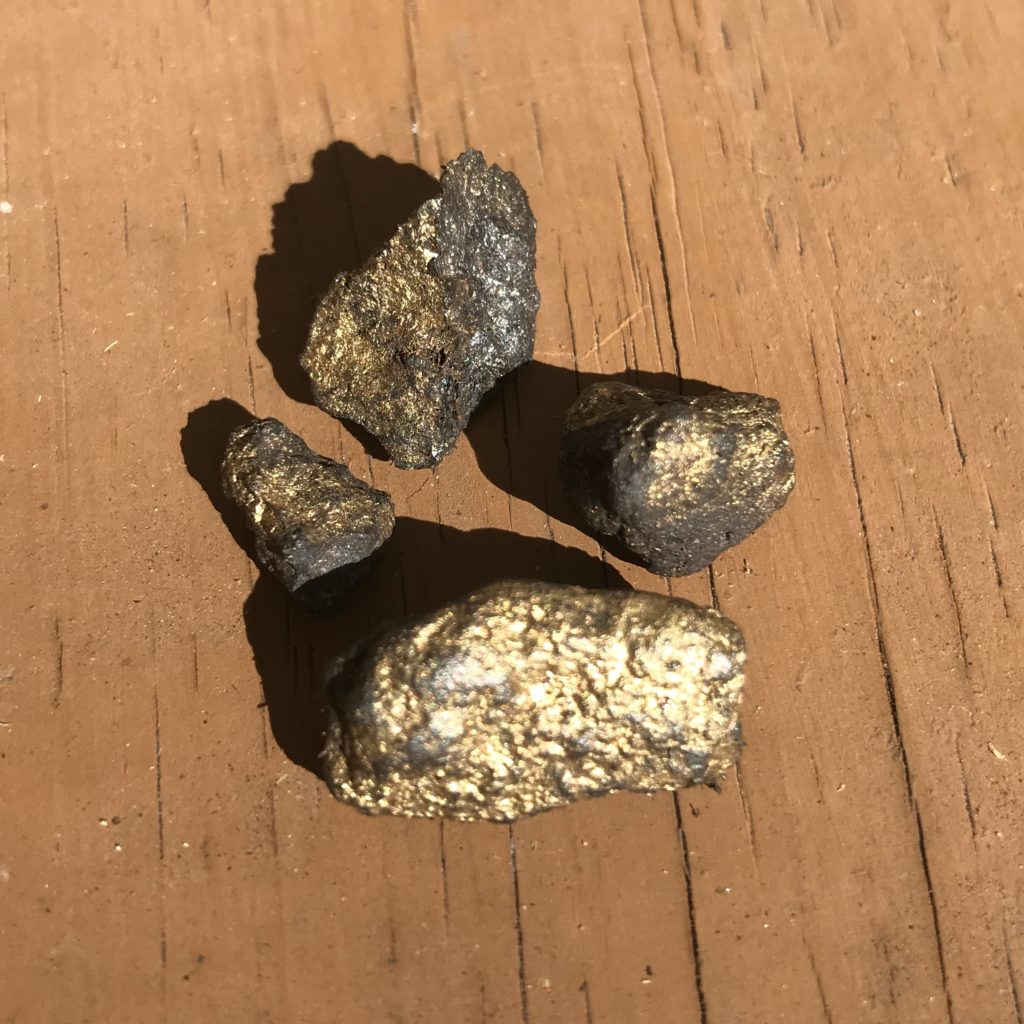
I immediately suspected they had been painted. So I ordered some up and sure enough, they’re just regular lodestone (magnetic magnetite) that have been painted up with gold paint.
I’ve seen them being touted to bring luck and prosperity. You can get those energies from all natural lodestone, so I see no need for the gold paint on them.
I did a quick search and unfortunately, with the three sellers I found; no one disclosed that they were painted lodestone. Then again, maybe the shop owners aren’t even aware.
 Yellow Tibetan Quartz | New Finds?
Yellow Tibetan Quartz | New Finds?
Now this one…
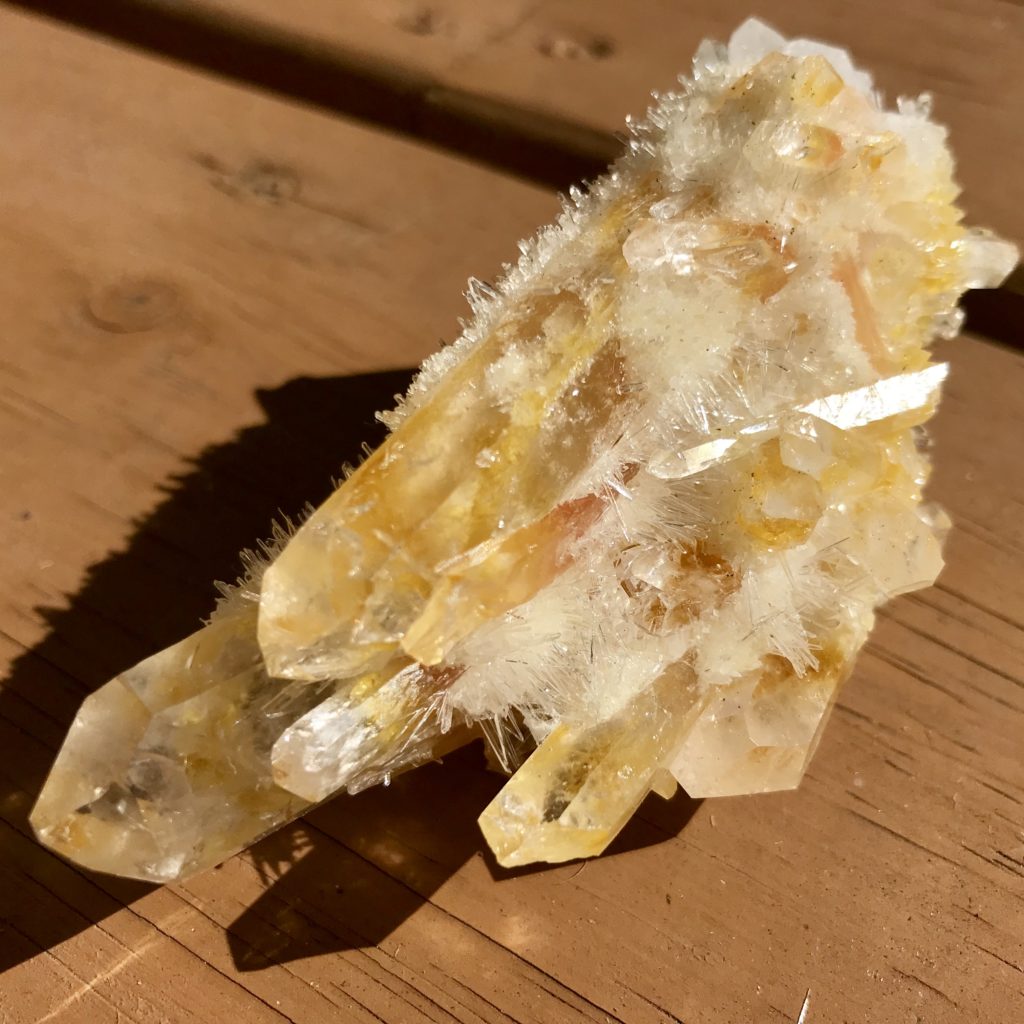
Captured your attention? Yep, mine too.
They’re pretty, there’s no doubt.
BUT, my experienced eye noticed that they looked a little too much like the synthetic green quartz I wrote about some time ago. I can tell from the characteristics that they used the same laboratory process as green quartz but have just started infusing a different chemical or dye to achieve these colors.
Yellow Tibetan Quartz/Spirit Quartz
The one in the above photo was listed as Yellow Tibetan Quartz/Spirit Quartz; most likely because it was purchased from Tibet, a popular spot where these sorts of synthetics often come from.
I could tell from the seller that they were not at all aware that this was a fake.
Let me tell you, I’m afraid to touch this spiny thing. Spirit quartz grows with tiny crystal facets on it. However, this thing has very fine crystal filament splinters growing on it that pierced me several times. It’s quite dangerous actually. That is NOT how natural crystal grows.
New Find Yellow Phantom Quartz Crystal
This next one was listed as “New Find Yellow Phantom Quartz Crystal Cluster Specimen”. I’m laughing… I can’t even get pissed anymore because this stuff has just gotten so ridiculous.
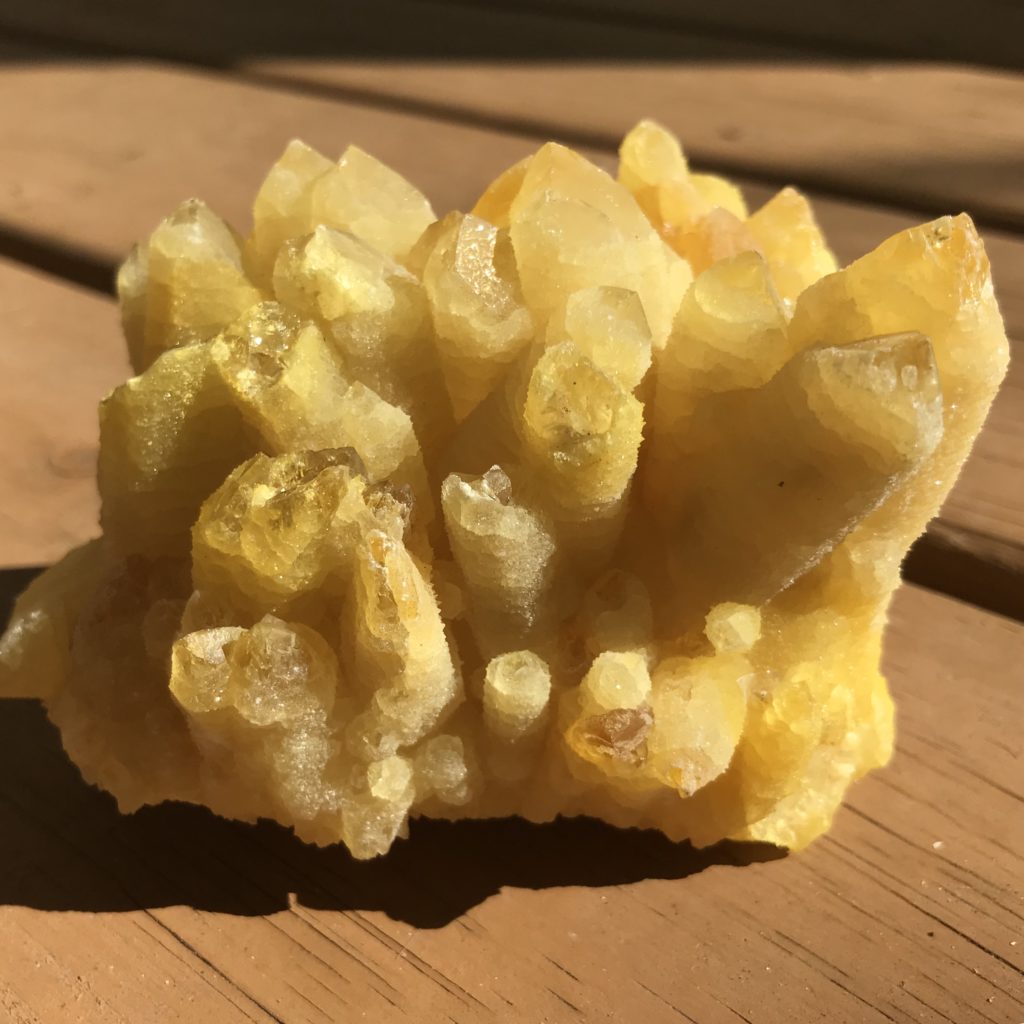
The listing also called this one “yellow citrine quartz”.
So which is it?
Citrine or Yellow Phantom?
I guess they thought the fancier woo-woo names they threw in, the better.
The listing also included this “helpful” info: “Please take note that each crystal will be slightly different from the picture due to it being a natural stone.” A natural stone you say? I don’t know… call me picky but I strongly feel that it needs to be disclosed when a mineral specimen is synthetic.
Blue Phantom Quartz
OK, I have to admit, this is one is pretty eye-catching. The Blue Phantom Quartz was obtained from the same seller as the above “Yellow Phantom”. The seller shipped from China. I suspect these were grown in the same lab.
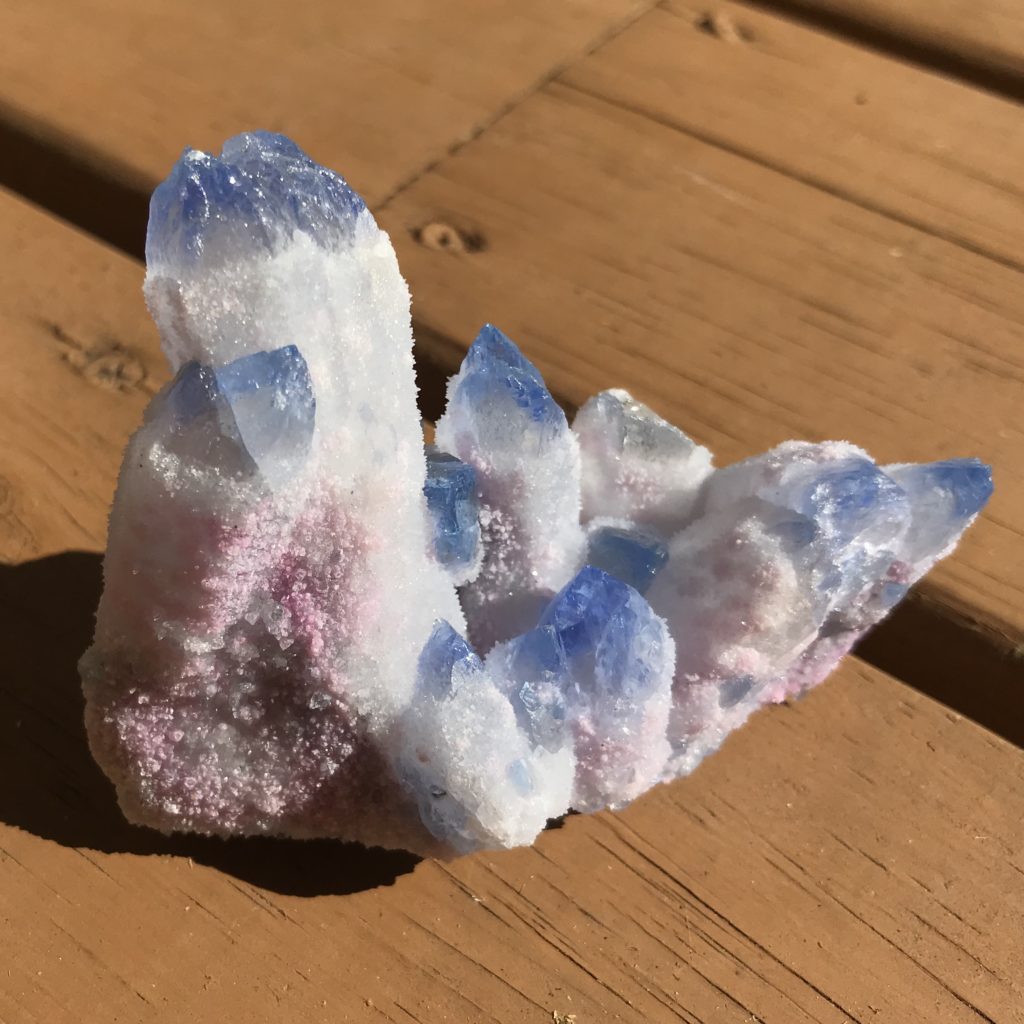
This one was also listed as a “Natural Quartz” and ironically the listing said this: “Blue Phantom in Quartz Crystal is, of course, a Throat Chakra crystal. It helps us speak our truth.”
Really?
Ok, so you’re probably wondering how I can tell these are synthetics.
Here’s what to look for…
DEAD GIVEAWAY TELL-TALE SIGNS to look for:
- Crystal tips and apexes that have an etched or stepped growth pattern; due to forced regrowth of a quartz cluster (or sometimes they’re entirely synthetic)
- Crystal apexes (tips) that are trigonal (3 facets) rather than the more common hexagonal (6 facet tip)
- More color concentration at apexes (even look like phantoms so may be higher in price!)
- Many of these specimens on eBay hail from China or Tibet (as did these examples)
- Can look like spirit or fairy quartz w/ the same sort of teeny crusted crystals points that tend to cover the crystal shafts; due to the forced regrowth, but the crystal growth is MUCH smaller than a genuine spirit quartz
Always use your common sense and the best protection from this is to be well-informed yourself.
Do your thing
If you choose to work with man-made crystals and you enjoy them just fine or it’s been working for you… as I always say:
“keep on ‘truckin’”. Don’t change a thing!
I just want us all to have the geo-knowledge first. Then you can make an informed decision regarding how you choose to work with these “stones.”
And as always, the moral of the story here is…
Buyer Beware: Who are you buying from? Are they reputable? Do they know what they’re talking about? Are you doing your own due diligence & research? The best way to protect yourself is education.
We all love the beautiful jewels that mama earth creates and you don’t know what you don’t know… until you know better. So, I hope you’ve learned something new here today.
Have you seen any of these or new crystal fakes or misrepresentations recently? Please share in the comments below!
Crystal Blessings,


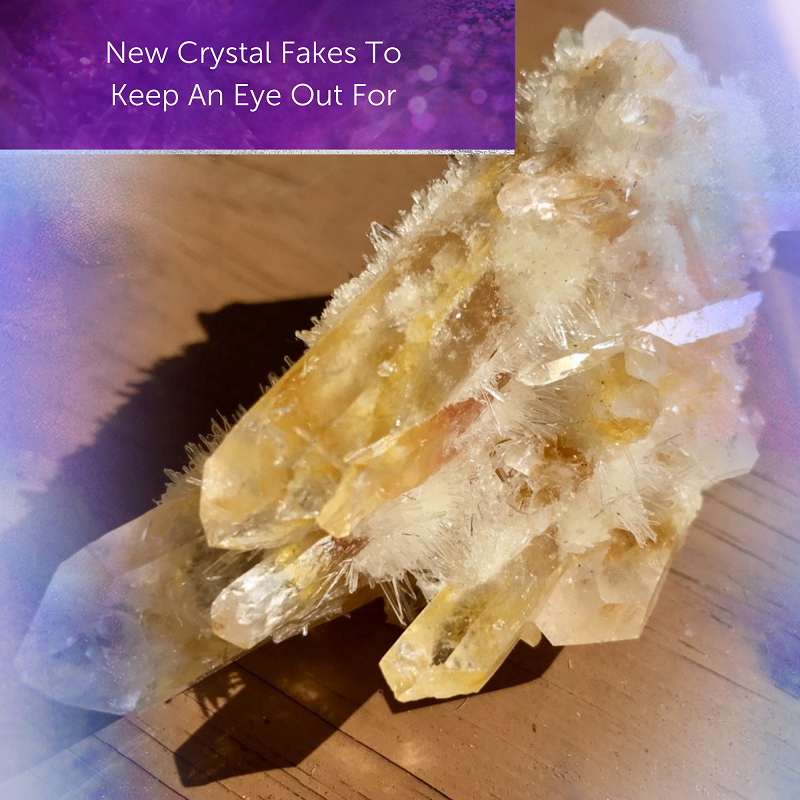
Very helpful article, thank you. I did buy some of the ‘green quartz’ via Ebay, knowing full well it would have been lab-grown. It is very pretty, and makes a nice ornament, and the cluster I have sits happily by my front door. I’ve not attempted to work with it though!
Thank you Hibiscus Moon!
I saw this too, especially in the yellow quartz. More and more Gem shows are painting stones. I hate that! I also hate when the market starts mass producing stones luje Mikdevite. If they are so rare, why are they being used as bath salts? ???????????? It is getting sad. I have a question. Us Hessonite Garnet a fake? Do you have a post in that? Yay I’ve realkt ticked be off. I feel sorry for the sellers too that don’t knock a. Thanks again.
Hessonite Garnet is a real type of garnet. https://youtu.be/tjN1yfKIFz0 They go into garnets at about the 30 min mark. Of course, it does not mean that there are not fake hessonite garnets out there, but they are a real stone.
Appreciate the word on Moldavite, just bought my first ever and it checks out as genuine, not cheapeither, tiny, but so exquisite.
Hi Hibiscus, thank you for putting the info out there for us. I think I’ve seen some fakes at a recent show, they were all prefixed with Tibetan….. one was black quartz, another was green quartz ( looked like your example of the spiny yellow but a pale translucent green) and amethyst. What are your thoughts on these?
I am looking for a spirit crystal, but I am not sure what qualities to look for. Where do they come from. Does color matter. Price range
Do you have any reputable places that you recommend to buy moldavite?
I have a black obsidian neckless and also a black obsidian stone… Now the stone is very light wieght but the neckless is not as it is wrapped with like some kind of wire…. But the stone is real shinny and the neckless is not… I also have a black onix pendent neckless. And the chips in it a very small… So really hard to tell anything about them…. But im really woundering about my black obsidian neckless and stone…. Im just hopeing i didn’t let myself get fooled… I do love my stones and crystals
This message is late in arriving, but I stumbled across your post in my hunt for answers on phantom crystals. From what I know in my research, you have two types of stone- onyx and obsidian. If you look them both up you will be able to tell soon enough what the differences are, but the short answer is this- onyx is not as shiny and is much heavier, it’s also much harder and worth a lot more than obsidian. Obsidian has a lot more of a glossy shine to it and is a lighter weight, it is also considerably cheaper. Most of the “onyx” these days is in fact obsidian being passed off as onyx, due to the price difference and obsidian being more abundant and easier to work with as it’s a form of igneous rocks (porous rock formed from volcanoes).
Hope this helps!
Can You check out this offering and tell me if the crystals are legit Green Phantom Quartz?
https://packagedeal.soulmalas.com/green-phantom-optin?fbclid=IwAR0lS-tNaY4KHRgJC966fdPMPtQlhmsPj8Pag0zKrmrrf8vsOiRqnNY_ICs
Definitely a fake, sorry. ☹️
If you’re looking for a specifically green phantom stone to work with, look up quartz with chlorite. The chlorite shows up as beautiful green phantoms or mossy inclusions, and it has a really lovely, vibrant energy to it (and you can find some pieces for a pretty decent price). A couple good ways to tell many of the fake clusters out there are that the color is coating the outside of the cluster (which CAN happen in nature–look at tangerine quartz, or some of the red/yellow hematoid quartz varieties, but they will usually be priced accordingly), and also the consistency of the colors. If there are extra deep colors at the tips, base, or around the cracks within the crystal, it can be a warning sign, as that is where the dyes tend to pool up and leave a deeper color. Hope this helps!
Thank you for keeping us informed. You are appreciated.
Wish is loaded with different kinds of crystals that look so beautiful. One was a White-yellow phantom quartz crystal cluster mineral specimen (you mentioned above), yellow-blue mineral specimen, natural green quartz crystal citrine mineral specimen, natural white quartz crystal cluster of original specimens. Etc… I am so glad I found this article, you have saved me some money but taught me some things. My son said to search the crystals because they did not sound real more like man made and he was right, thank you
I found a Tibetan Green Phantom Quartz in a shop today I’d love to be able to know if it’s a wise choice to buy
Hello everyone! I love the comments left by crystal lovers out there. It helps to know others’ experiences with crystals. HM is THE source to trust! She makes no excuses for those who peddle questionable items. She tells us the FACTS with as much compassion as possible as we all can be fooled into purchasing something beautiful from any vendor who is well schooled in selling…even if the vendor is unaware of the fact that they themselves fell prey to a fake! Do your homework, as HM reminds us. Thanks HM for all your hard work and experience you bring to the world of crystal enthusiasts!
Congrats on your new Trademark! Your relentless pursuit and support of your students to properly educate us so the credentials you offer support us in the world of business is above and beyond anything I have experienced from other teachers! Thank you!
Hi ty a lot for this post
Thank you so much for this post! I’m always so worried about buying expensive Moldavite, because I know it’s so rare. (and becoming harder to find – especially anything affordable) I looked for the threads in the pieces I have, & i’m happy to say they’re there. (Whew!)
i’d love it if you addressed another techite, phenacite (phenakite) A lot of phenacite is being sold as clear quartz, and it’s hard to know the difference. Can you address this in a post, down the road please?
I have all of my Crystal family charging in the full moon tonight.
Thanks for all your work with crystals, and in helping us!
Brightest blessings
Thanks so much for the info. I actually came across some yellow double pointed stones I thought I was getting natural citrine but when they came they were more of a yellow yellow(not heat treated amethyst either) so I thought calcote well when I asked they said they were Lemon Quartz. I’ve done a little bit of research but I was wondering if maybe you can do a is it Fake # on lemon Quartz?